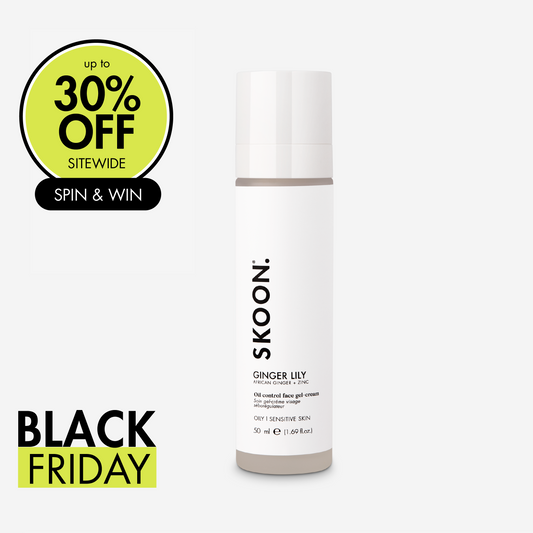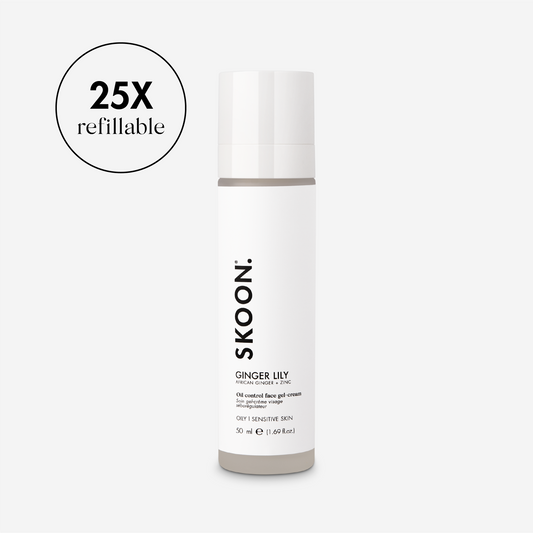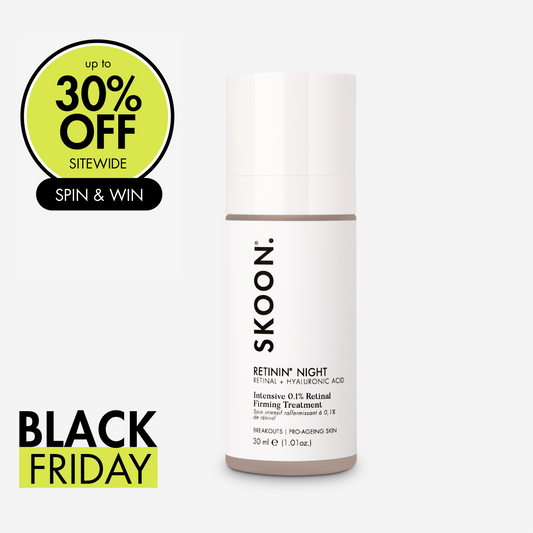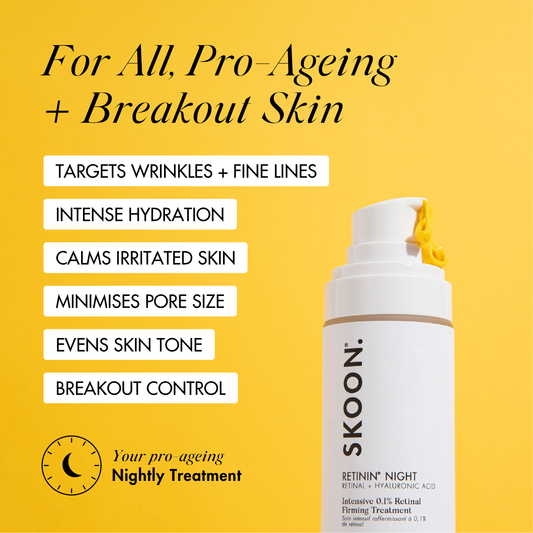Elizma S.
Can not recommend this product enough!
Annemarie J.
I have roseaca and roseaca change your appearance of your skin on your face and nose. So I had like 2 bumps growing on the sides of my nose and other more not so prominent hives coming up. It took 1 year and those bumps are gone! The other hives coming up 2 days and it is back to normal, does not matter how red or how blistery it is. This product is absolutely the very best. I can reccomend this percent. Love my Skoon products
Hanliette M.
Love the smell!!
Lizelle d.
Love this product
Faaiza M.
I have been using it for the past two weeks and it seems to work well for spots! It does have a strong smell, but I dont mind it.
Anke V.
YES!! This is a must have, especially when I'm nearing my cycle.. it literally works overnight, I am still amazed every time :)
Nicola L.
I love this product! I normally use a stronger spot stick on my blind pimples but have been using this product for 2 weeks now and my next has never been clearer. I am very happy.
Marlize E.
Bought the product for my 18 year old son. He uses it twice a day after applying Happy Flora moisterizer. He exfoliate twice a week with O Sherbet. Still struggle with acne breakouts and marks on his face
Pelonomi M.
A good product indeed! I will recommend it, I love it
Ansule S.
This product really helped with keeping breakouts under control
Keir B.
I bought this for my teenaged daughters & both their skins have cleared up so much since starting to use this product. We'll definitely keep this on our "must have list"
Sunel B.
I bought this for my teenage son and it works wonders. So recently I have been getting breakouts ans started using this product and I have to say. I am truly impressed. Wish I had this when I was at school with teenage skin.
Eline V.
I have been using the product for just a short while but it does what SKOON advocates it for! Very happy with the results.
Michelle M.
My daughter loves it.
Angelique W.
Great product, clears quickly. Makes your skin really soft without over drying.
Pam T.
I bought this for my daughter who has had endless struggles with her acne ! Within two days of using it she saw an improvement, and her skin is looking and feeling fantastic ! She is so happy !
Ester v.
Smells so lovely. It actually works!
Jade G.
It's easy to use, smells good and really helps my skin with redness and blotches
Denico B.
It’s only been 10 days, but so far so good
Atiyyah L.
Great product. Helped tremendously with cystic hormonal pimples within a day the inflammation was reduced and after 3 days the pimple disappeared.
Riana H.
Ek is mal oor die produk!! Ek het 2 tiener seuns en hulle kan dit saam met my gebruik! Daar is 'n groot verbetering in ons veltoestande .... en as jou vel goed lyk, voel jy goed en jy pak die lewe net aan met daai ekstra selfvertroue! Baie dankie!!
Annelize F.
Very impressed with your products!! Will be ordering more soon.
Thank you
Kesja D.
Bought for my teenage son, it works amazingly, we both super impressed with it.
Renate S.
I’ve been using it for two weeks now and already seeing a HUGE difference. Really would recommend this!
Shelley H.
I love that Spotless is a 100% natural product, so not harsh on my skin. It's an excellent spot treatment and a MUST HAVE!
Lara R.
It's fantastic! I use a bunch of skoon products and they're all great.
Gracia N.
Its works well in reducing my acne spots. Some reviews said in one day, this is not my case, but it does work over a few days
Savannah M.
I was skeptical in believing that something could just clear up spots but this REALLY works! Have definitely noticed a change in my skin since using it.
Juanita P.
Love this product!! It works.
Madelyn C.
Bought this for my wife. Shes 32 and always struggled with her skin. She tried every product you can think of and nothing worked. After using this only for 2 days I already saw so much improvement. It really works so well and she is very happy with it
Belinda S.
The most amazing product! Works quickly and effectively.
Sias V.
The quickest, best solution to stop any spots from getting out of control.
Danielle H.
Love the smell and it is compact enough to take with you in your handbag
Vivian P.
The wonder oil. Literally worked on the go. It is also helping me not to pick on my skin as I used to because I know once I apply the oil, the pimple will reduce and eventually disappear. Love love it.
Lana G.
great product! works like a dream. great for teens
Franci H.
I really love this product. With spot treatment I have become sceptical, because many products do not work. This is however a complete game changer. Works like a charm to calm spots down quickly. The next day its almost like you didn't have a spot to start with!
Candice S.
I’ll definitely never go without this again. Most effective spot treatment I’ve ever used by far.
I suffer from hormonal breakouts, and sometimes get quite painful blemishes that last at least a week. This vanquished a blind spot in just 2 days, without any of the usual redness, pain or irritation - it’s absolute magic in a bottle!
Fourie C.
Unfortunately it is not working as good as advertised.
Abi D.
I am truly absolutely loving your entire range - best purchase i have made and i have it all - just love it - thank you
Victoria C.
Love this treatment! It resolved my blemishes within a few days. It is a must have. Wont be without it going forward.
Jolene R.
This spot stick is amazing. Extremely effective and smells fantastic.
Mariette .
This blemish stick might seem pricy, but it's worth it! Since it's roller application, it will last months and I really have seen it work wonders. Yes the smell is strong but it's not unbearable (just essential oil-ey :).
Natasha V.
My daughter dropped our skoon blemish cream on the first day it arrived and it broke!
Erin A.
I use it every time I see a spot start developing and the spots I had prior all faded away within 2-3 days. Just a dab in the morning and before I go behind works wonders.
Tessa W.
I have never used a product that works so fast. I only get breakouts during my menstrual cycle and this works wonders.
Asanda M.
Been using Skoon products for over a year now and I can’t brag enough! Highly recommend it. Fixed my hyperpigmentation and dark acne spots within a couple of weeks using it and I’ve never looked back.
Charlene P.
Everyone needs this! Literally within 2 to 3 days, that dreaded little hormonal spot is vanquished! Cannot recommend this product enough
Cindy P.
I used skoon for the first time. The roller for acne was so good so i decided to try the day cream for oily skin as well. It works wonderfully . My acne has cleared and my skin is less oily. I am very happy with the products
Nicolene M.
I am yet to see a difference after 4 days of use but it smells amazing***
Deidre C.
Love the roller and it smells good too.
Maseehah
The spotless blemish remover is such a life saver it makes the marks of Anne much lighter and it smells soo good
Tricia L.
I get hormonal breakouts time to time and there’s nothing worse than waking up with a hormonal break out at 48 - this formula works quickly to get rid of the problem. In a day or two all clear again. Thank you Skoon for a brilliant and convenient product that lives up to its promise.
Beverley M.
This product is AMAZING! I suffer from sore cobuncles (sp) and I've battled for years. I received this on a Thursday and by Sunday it was dried out and virtually gone. Never used something that cleared my skin so fast. Highly recommend.
Samantha H.
This spot roller works really nicely. It dries out spots gently and effectively.
Faranaaz G.
Breakout a lot ? Full of marks
Christa D.
Sporadic breakouts come at the most inconvenience times. Spotless seems to help clear up my skin a lot faster.
Millicent T.
It REALLY WORKS!
You can not only see, but you will FEEL it work.
Due to my whacky hormones, I often break out on my chin. Within a couple of hours of dabbing this magic wand on the noticeable bump, the redness and swelling disappear, and by the 2nd day or so - it is completely healed. It's the best spot treatment I have ever used. Love it ♥ It smells amazing too.
Lisa S.
It’s ok. The smell is strong but that does bother me. But the Oh Sherbet face mask is much more effective in dealing with spots and breakouts so this little guy doesn’t get much use.
Sharon R.
Got it for my teenage son who has sensitive skin and acne. It’s fantastic, smells fresh and definitively reduces redness and aids healing
Samantha S.
Absolutely love this blemish stick . It’s a lot fe saver ! So happy that SKOON products have come into my life !
Emma S.
It's my first time using Retinal and I really enjoy how it makes my skin look and feel. It seems to help close my open pores and create a general smooth tone to my face. Highly recommend!
Lara R.
It really works!!! Within a day the inflammation of sore pimples goes away.
Deborah S.
My teenage son is using the roller stick. It works like a bomb. Spots dry out quickly and his skin is much clearer than it was previously.
Angelique D.
Every now and then I have a hormonal breakout. This product takes care of it. Two days and the
redness was gone and the bump disappeared.
Chantel N.
This spot treatment really helps to reduce spots without irritating/burning my skin like other spot treatments. Love it!
Amukelani S.
The scent was too strong and made me itch and breakout
Aletta W.
Voor aknee erger raak verdwyn dit! Wonderlike produk!
ELIZE L.
I am a definite yóúng 60 plusser because I still get blemishes here and there from time to time! The ónly product I have tried so far to clear up this inconveniency with immediate effect, is this wonderful roll-on oil by SKOON. Buy it …. !! One cannot go wrong …..
Lea N.
My teen daughter loves this product. She uses it whenever she has a pimple coming up and it brings immediate relief and within a couple of days it has disappeared. It best to use it at night if you need to apply on several spots. For the day just lightly tap on the pimple and don't put too much.
We love the scent; particularly at night.
Please keep this product in your product line! It is one of our basics which we buy regularly.
I wish Skoon would make a range of teen products or advise which other products would be complementary to this stick, We would happily try them all.
Amelia M.
Really enjoying this product so far. Have only been using it for about 2 weeks and can already see noticeable differences in my blind spots. It does not aggravate my sensitive and dry skin.
Nicole F.
This is magic in a bottle! I have been struggling with breakouts for a while and using the blemish spot treatment helps ease the breakouts and they disappear so quickly!
Wendy W.
My son says it’s helping with his acne. Did buy another stick .
anneke
Instant
I got this product yesterday, it took down the swelling of my pimples within hours. This morning they are almost gone. I am so impressed. I can’t believe I didn’t have this sooner.
Nataliia v.
The application is comfortable. I like that the bottle is transparent.
The smell is way too strong. I once used it before going to the office and was suspected of applying nail polish during the work... I literary had to pull out the product to prove myself innocent.
I assume it works, I do not see the results though.
Ncumisa Y.
This really does its job well. Spots and marks look so much better faster.
It has a strong herbal smell - but is so worth it.
Lara R.
This stuff is magic!! I get horrible huge blind pimples which are really painfull and lasts weeks. After three days of applying this stuff morning and evening, the pimple was gone.
Ayesha Imandin
Bye bye bumps!!
My husband says i should be a skoon ambassador as im so obsessed with ever single prpduct!
Today i bought the spotless for breakouts! If i tell you! It gets rid of the biggest or smallest spot ever! Within two days my face was clear especially from those sore tight feeling ones! When my kids become teens this is what they will use!
And mind you, i love the smell! Fresh and bold!
Tanya van Tubbergh
Works great but strong smell
This is one of my favourite products - it really works well to calm spots and help them heal faster. The only downside is the strong smell. I've become used to it and it no longer bothers me but I wouldn't use it anywhere other than my own home because I would feel a bit self conscious walking around smelling like potent tea tree oil. Having said that, it works so well I'd still continue buying it!
Carina Coetzee
Spotless? More like flawless
Instantly calms breakouts- I don’t go anywhere without it!
Monique van Zyl
Monique
Wonderful product, spots reduce within a day & disappear within two days. So happy with it!
Sarah Herr
Absolute perfection!
I felt a change in my skin texture from the very first use. As someone with highly sensitive skin, it has not reacted negatively to the products at all!
Celeste
Opinion from someone sensitive to scents
I can't tell you if this product works, as I could not keep it on my skin for more than half an hour. The "calming, clearing botanicals" has a scent that is incredibly strong. I am someone who is quite sensitive to smells, but this permiated everything and I could even taste it in my coffee.
For this price I expected more, and I would not recommend this product to anyone who might be sensitive to any strong smelling products.
















